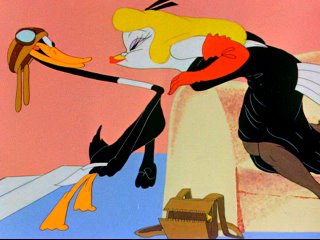A problem that's existed ever since the mid-50s in animation is the abundance of 'talking heads'. This started coming in with Chuck Jones' "illustrated radio" shorts, but it really didn't take off until the advent of television with Hanna-Barbera's first shorts.
All cartoons, theatrical or otherwise, have relied on verbal humor and dialogue far too much ever since.
Back in the "good ol' days", masters like Pete Burness and others were able to make their talking scenes interesting, because they would add their own little tricks to them.
This is a scene from one of Friz Freleng's Tweety cartoons, I Taw a Putty Tat (1948). I believe this is Burness' first piece of animation for Warners, though he was uncredited. Watch Sylvester's head in this scene for Burness' trademark bouncy animation, along with the neat detail of Tweety's hat bouncing off his head as he jumps with joy, 'unaware' of Sylvester's intentions.
It's easy to tell when Pete or Emery is animating on a Freleng cartoon because it's usually the best looking animation in the short.
Burness, along with Emery Hawkins, were at the 'bottom' of the Warners pecking order, so they weren't tied down to one unit, and would often go without screen credit.
Here's Burness handling a classic exchange in Chuck Jones'
Haredevil Hare (1948), another short he was uncredited on. This gag has been used countless times throughout animation history, but it was never as funny looking.


